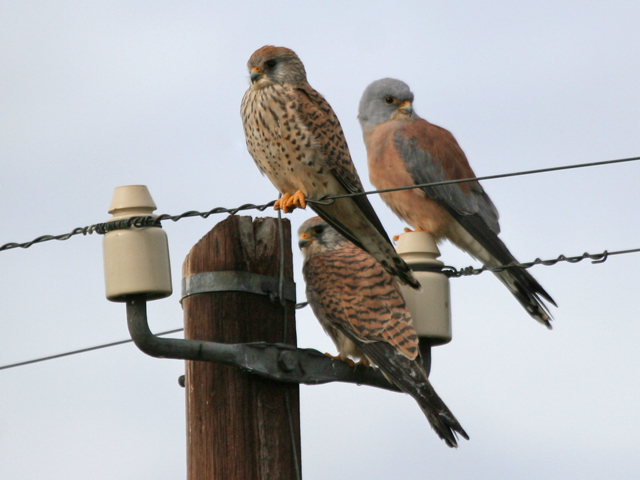|
| Query: bird | Result: 2209th of 32675 | |
Lesser Kestrel (Falco naumanni) - Wiki
| Subject: | Lesser Kestrel (Falco naumanni) - Wiki
| |

| Resolution: 640x480
File Size: 198207 Bytes
Upload Date: 2007:01:08 17:06:04
|
Lesser Kestrel
From Wikipedia, the free encyclopedia
[Photo] Male and female Lesser Kestrels. Photographed by Neil Gray on 25 February 2006 near Hanover, Northern Cape, South Africa. Camera: Canon EOS 20D Shutter: 1/1600 sec Aperture: 5.6 ISO: 200 Focal length: 375mm
The Lesser Kestrel (Falco naumanni) is a small falcon.
This species breeds from the Mediterranean across southern central Asia to China. It is a summer migrant, wintering in Africa and Pakistan. It is rare north of its breeding range, and declining in its European range.
It nests colonially on buildings, cliffs, or in tree holes, laying up to 3-6 eggs. No nest structure is built, which is typical for falcons.
It is a small bird of prey, 27-33 cm in length with a 63-72 cm wingspan. It is very like the larger Common Kestrel but with shorter wings and tail and pale claws. It shares a brown back and barred grey underparts with the larger species. The male has a grey head and tail like male Common Kestrel, but lacks the dark spotting on the back, and has grey patches in the wings.
The female and young birds are slightly paler than their relative, but are so similar that call and structure are better guides than plumage. The call is a diagnostic harsh chay-chay-chay, unlike the Common Kestrel's kee-kee-kee.
It eats insects, which are often taken on the ground.
The scientific name of this bird commemorates the German naturalist Johann Andreas Naumann.
http://en.wikipedia.org/wiki/Lesser_Kestrel
| The text in this page is based on the copyrighted Wikipedia article shown in above URL. It is used under the GNU Free Documentation License. You may redistribute it, verbatim or modified, providing that you comply with the terms of the GFDL. |
|
Comments |
|---|
| | Guest |
|
| 흰발톱황조롱이 Falco naumanni ( Lesser Kestrel ) |
^o^
Animal Pictures Archive for smart phones
^o^
|
|
|